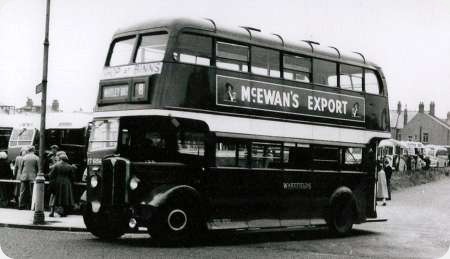
Wakefields Motors
1948
AEC Regent II
Weymann H30/26R
Having completed its journey, 156 is seen here turning round at Whitley Bay Bandstand before returning to North Shields Ferry Landing. The service 8 was known to crews as ‘the track’ because it followed the exact route of the Tynemouth and District trams. The AEC Regent II chassis was well built, rugged and reliable, and was available in two options, take it or leave it. The engine was a 7.7 litre diesel, and the transmission was a 4-speed sliding mesh gearbox with friction clutch. It was an entirely different matter when it came to choice of body. NGT Percy Main depot opted for the H30/26R Weymann. This is one of twenty nine of the type delivered to them between 1947 & 48; the 1947 intake were FT 5698 to 5712, 128/142, and 1948 were FT 6143 to 6156; 143/156; they were all ‘Tynemouth’ apart from 141 – 142 & 156 which carried the Wakefields name. The first vehicles to carry this style of livery layout were the 1958 Orion bodied PD3/4’s, so the photo is after that date, but just look at the collection of coaches in the background.
Photograph and Copy contributed by Ronnie Hoye
10/11/14 – 06:58
Good to see a Regent II. I used to take them for granted in Reading, where they were the mainstay of the motorbus fleet from 1947 to 64, but they seem rare today. Was the choice of 5 bays a matter of date, of chassis design or of operator’s choice?
Ian T
10/11/14 – 08:23
According to “Weymann Part 2”, these were delivered (due to shortages) without destination blinds and with metal panelling covering the “empty holes”.
David Oldfield
10/11/14 – 11:47
I think that the matter of 4- or 5-bay bodywork is a matter of date. The 5-bay was standard in the immediate post-war years, on AEC and other makes. I am fairly sure I read somewhere that Weymann re-designed the body as four-bay for the AEC Regent III chassis, but did not build it on other makes/types, at least initially. Perhaps those with access to the “Weymann Part 2” book will find some detail, as my memory may be in “error mode” on this one.
Michael Hampton
10/11/14 – 13:31
Michael, I don’t know when the change came about, but Percy Main’s 1952 Guy Arab III’s ‘FT 7381/90 – 181/90 were four bay type. They were also P/M’s first 8ft wide D/D’s, and the first with sliding cab doors.
Ronnie Hoye
10/11/14 – 13:32
I think, originally, that AEC and the body-builders colluded to make a four bay body – but it relied on body fixing points. Guy and then Leyland eventually caught up by building chassis with compatible points and then Daimler. [Bristol was obviously a different case.] What was more interesting was the reversion to five short bays with the appalling early Orions.
David Oldfield
14/11/14 – 14:56
What was the difference between a Regent II & III’s. We had Regent III’s in Sheffield around the same year. They had pre selector gearboxes though.
Andy Fisher
15/11/14 – 05:41
AEC Regent. Mark I, II and III.
AEC Regent 661 petrol engine was built from 1929-1942, powered by an AEC A145 7.4 litre engine, many of the early examples had the open staircase later enclosed and the typical 30 seats over 26 seat layout became the standard design on a 27 foot long by 7 feet 6 inch wide chassis with over 7000 built.
AEC Regent Mk II 661/O661 was developed in the late 1930’s at 27 feet 6 inches by 7 feet 6 inches with the A173, 7.7 litre 6 cylinder diesel oil engine, resulting in the London Transport RT 1-151, the Regent II was curtailed during the second world war but recommenced after the war with only 700 built.
After the war AEC with London Passenger Transport Board had developed the AEC Regent III O961 with the more powerful AEC 9.6 litre engine. 8261 were built over the next 10 years, most of these were the iconic RT for London Transport.
Ron Mesure
15/11/14 – 05:42
The Regent II had a 7.7 litre engine, sliding mesh gearbox and vacuum brakes. The Regent III was its successor, and could be supplied with the same spec, in which case there was very little difference between the two. Most Regent IIIs however had the 9.6 litre engine, and many of these had air brakes and air-operated preselector gearboxes (especially in Yorkshire!). In this form the Regent III was a development of the London RT type which had its origins just before the war.
Peter Williamson
14/12/18 – 06:24
I have only just noticed that four years ago Ron Mesure attempted to give a fuller and more detailed answer to Andy Fisher’s question than mine. Unfortunately this is mainly incorrect.
Firstly, the petrol engines used in the Regent 661 were of 6.1 litre capacity, the 7.4 litre A145 being reserved for the three-axle Renown. Diesel engines included an 8.8 litre and a 6.6 litre unit as well as a couple of Gardners (rarely fitted).
Secondly, the version with the 7.7 litre engine was not called Regent II before the war and did not include RT1-151, which used a 9.6 litre engine like all subsequent RTs. Although designated as O661 and built before the Regent II was introduced, RT1-151 (and an odd similar chassis for Glasgow) are now regarded as the first Regent IIIs.
Thirdly, the lengths quoted are incorrect, as the maximum length of a two-axle double decker was 26 feet until 1950.
Peter Williamson
Leave a Reply